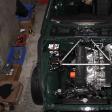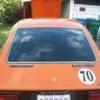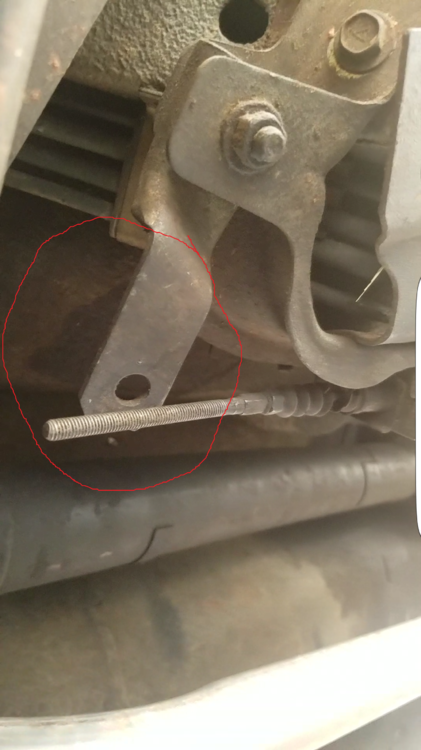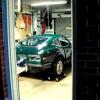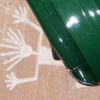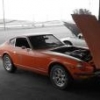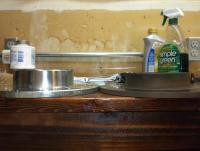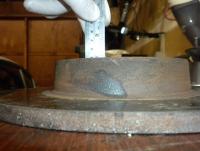Search the Community
Showing results for tags 'brake'.
-
Hello Guys, since last weekend I´m owning a 280z which will be fully restored and therefore I`ll change every component that was/is in contact with fluids or has orings inside. Especially the brake system. So when buying new parts I also could just spend a little more and get "better" parts. So the idea came up for a brake upgrade. I was reading a lot of threads about rear disc conversion in a couple of forums together with the problems that go along with it (brake bias, not for this stress designed axels etc.) Together with the fact that I`m out of germany and its not that easy to get it road legal with a disc brake where normally a drum sits. I was deciding to leave the stock drums and just get new pads, hardware and wheel cylinders for the back. In the front I`d like to install a vented disc setup. That this setup works well was backed by the nissan competition catalog were as far as my understanding goes they installed a 4 piston caliper with 41,3 mm dia (FIA MK63 brake) a vented disc and changed the rear drum wheel cylinders to 13/16". Nothing else was touched - is that right? So stock proportion valve, stock 7/8 master. My problem is I can`t find anybody who did this swap before due to the fact that everybody goes straight to a rear disc conversion which I don`t wanna do. So seems that two upgrades would be possible for me. The vented S12-8 from a 88 L4 4runner with vented discs (couldn`t find a kit online) with two 43 and two 34 mm dia pistons in each caliper which seems to work good with a rear disc setup. Or the S12-W conversion with four 43 mm dia pistons. If you go through the other threads a lot of people say that the S12-W is really heavy but I couldn`t find any numbers. Wheel clearance wise the S12-8 vented should also be better than the S12-W. So what we know is that the original nissan upgrade works well. To check the bias change I was trying to do some calculations based off the premises you don`t change pad compound, leave the rear drum alone (besides the piston dia on the FIA brake). So as these values would be all the same you can remove them from the calculations - right? Question is only by how much a little bit bigger padarea would make a difference and also a couple mm bigger dia disc would make a difference. What I did is not the REAL brake bias but I guess its a good starting point to only compare these three systems to each other. Or what do you think? So the FIA Brakes are 4 piston with 41,3 mm dia the rear drum cylinder are 13/16" so 20,6375 mm dia. So in total you`ve 8 pistons up front which combined have 10717,168mm² while the backs are two pistons each side so four in total with 2676,048 mm² together. S12W are 43 mm dia and stock 280z rear drum cylinder are 7/8 so 22,225 mm dia. Same number of pistons so up front 11617,608 mm² and rear 3103,584 mm². S12-8 vented has 4 pistons 43 and 4 with 34 mm that makes 9440,484 mm² plus the same in the rear like one above with 3103,584 mm² That makes a 80/20 distribution with the MK63 FIA brakes and 78,9/21,1 with the S12W and stock drums 75/25 with S12-8 vented Mounting points are the same so you don`t have different leaver. Considering you run the same pad compounds. Which have almost the same dimensions as well. You also should have the same pressure because they are not changing the master. Which I probably would due to the necessity of more fluid - so a 15/16 master would probably go in. Seems that the S12W is a pretty close call compared to the original vented upgrade with MK63 and 13/16" rear drum cylinders. What do you think? A manual willwood proportion valve (the black one) could also get rid of that 1% difference and would remove a tiny bit line clutter in the engine bay. Is someone running that setup and has some rekomendations or experience? Because you can talk and calculate a lot, but when it is not even noticeable in the end...IDK. The car will go down the performance road, so upgraded suspension, wider wheels, overfender, around 200 HP (hopefully) etc. BTW out of jdmjunkies.ch: MK63 Solid disk type including brake-pads: 4.300 KgsStandard two pot OEM including brake-pads: 4.445 Kgs what I found on an other side is 3,8 kg for the vented MK63 without pads - not really comparable. And I did`t find anything about the S12W or vented S12-8... Thanks for your help, much appreciated
-
Hi all, Had a setback recently with brakes. I have installed: new hoses, hard lines at the drumps, pads, rotors, calipers, rebuilt the drums, and a new master cylinder. I have bled brakes before and as usual started with the furthest from the master cylinder (start with the rear left, then rear right, front right, front left). My issue is starting with the rear right, I'm not getting any fluid to pump from the master cylinder to the bleeder. Even when completely disconnected this doesn't work. I am assuming that I have a blockage in the hard lines and wanted some advice on clearing it. I am using the old school method of pumping the pedal and want to know if investing in a pressure bleeder might work or if I'm missing something altogether. I DID bleed the master cylinder without issue. Chris
- 20 replies
-
- 1
-

-
What's going on guys. I've got a 1979 280zx N/A 2+0 and I don't have much experience when it comes to e-brakes and its components... I need to know if I'm missing a part where the red circle is on the picture. I have the cable itself but I have no clue what the part in the picture screws into.. I read the FSM and it shows that there's supposed to be an equalizer there but I just don't know if I'm overlooking something stupid. I just bought the car from a guy who took great car of her and he did say they took off the e-brake when they were replacing a half shaft...? Do you really need to remove that?....oh well.
-
Today, I started on what I hoped would be the straightforward job of rebuilding the brake master cylinder for my 70 Z. Disassemble, clean, install new seals and hardware, and reassemble. Job done. What could go wrong? Unfortunately, I only got to Step 2. After cleaning things out, I found a little divot in the floor of the cylinder bore, located about 1/2" aft of the rear stopper bolt. Hard to say what cause it. The car has been sitting for many years so I guess it corrosion damage. It's about 1/8" in diameter and deep enough to catch my fingernail on. The rest of the bore is in great shape. When I look at the cross-sectional view of the Brake MC in the 71 FSM, I see that this divot sits pretty much mid-way between the front and rear seals of the rear piston. Knowing that, it doesn't seem like the seals stand a chance of being nicked by it. Nor do the rear piston and seals that came out of the cylinder look like they've been hurt by it. So - Question 1: Can I get away with just leaving it as-is? If the answer is that it's going to be ok to ignore it, then I've still got a minor problem in that that the rebuild kit that I bought a number of years ago is not suitable for the 70 - 71 brake MC -- different seal types (even though the bore is the same). That leads to... Question2: Anybody know where I can get a rebuild kit for the 70-71 MC? If the answer to Question 1 is 'MC must be replaced', then I've got a much bigger problem. The 72 MC, while an improved design, has the front and rear reservoirs and lines flipped around -- which means that my hard lines won't fit. Plus, a 72 MC would dilute the 70-ness of the car's engine compartment (a small but touchy consideration). MSA lists the early-design Brake MC as NLA. The typical parts suppliers also show 'NLA'. Then there's Rock Auto... Rock Auto shows NLA for 70, but lists two units for 71. One is from Cardone, the other from Centric. When I look at their 72 listings, there are about 6 choices, including Cardone and Centric. The 71 and 72 Centric units have the same PN, so that one's undoubtedly the 72 design. The 71 and 72 listings for the Cardone units, however, show different PN's. In addition (although this may mean nothing), the pop-up picture of the 71 Cardone unit shows the 70-71 design, with the 'F' line/reservoir at the front and the 'R' reservoir/line at the rear. Question 3: Does anyone have any experience with the Cardone unit listed under '1971' from Rock Auto? Could it possibly be the real deal? (i.e. the 70-71 design). If these 70-71 brake MC's truly are NLA from anywhere, what do members recommend as a remedy. Am I really going to have to fit new hard lines? or... Question 4: If I am forced to fit a later-style 72 MC, does anyone know if I can install the internals from my 70 MC into a 72 casting , thereby keeping the reservoirs/lines in the correct, 70-71 orientation? Both castings have a 7/8" bore and -- other the placement of the stamped 'F' and 'R' markings -- I think they may be identical. Intuition suggests that the factory would have made efforts to keep the same casting when they upgraded the design, limiting the changes to the internals (and the hard lines).
- 8 replies
-
- brake
- master cylinder
-
(and 1 more)
Tagged with:
-
My 240z has hard brake lines connected to the stock brake proportioning valve below the master cylinder. There is fluid seeping from around these hard lines even though the nuts on the proportioning valve are cranked down tight. I'm going to be upgrading my master cylinder to install 4 piston calipers which I've had on hand for a while and can not seem to find somewhere to purchase a new proportioning valve (which I believe is the issue). Thank you for your help and any comments or thoughts would be greatly appreciated!
-
I need some Datsun material science advice. Last years thread talks about fabricating insulators to replace the old rubber for the car's plumbing. http://www.classiczcars.com/forums/showthread.php?t=29518&highlight=brake+line+rubber What is a good source of rubber for this task? Something like this... http://www.amazon.com/Superior-18-1701-Rubber-Spring-Booster/dp/B00029K20M/ref=pd_sbs_auto_3 or maybe this http://www.jewelrysupply.com/index.php?main_page=product_info&products_id=20399
-
Hey All, While I have the suspension out and replacing more bits and bobs on the car, I decided to refresh the rotors and brakes while changing the shocks and springs. I went to install some new 240z rotors I picked up but they are much taller in the hat then the old rotors I have. After looking around here and hybridz I am wondering if I have had my hubs replaced by 280z hubs some where in the cars life, or that I have the wrong new rotors. How I can tell the difference? The photo below show the difference in rotor hat sizes, even taking into account the wear of the rotor~2mm or so the hat is ~8-10mm taller than the old one. I am wondering if I had 280z rotors on the car? Does anyone have a 280z rotor with measurements so that I can compare? Or if there is a way to look at the hubs and know for certain if it is a 240z or 280z hub? I searched for this information all over but I could not find anything. If I missed it please send me to that thread.
-
So i just bought this 1983 280ZX turbo and my brake lights are not working. the bulbs are fine because they come on when i turn on my running lights, but when i press the brakes they do not light up as they should. Im a newb when it comes to working on cars, especially Z's. but i want to learn everything about this car in and out. hopefully somebody can help me out with this issue. Thank you, Andy
-
Looking for suggestions... I just tried installing the Motorsport Auto 4-piston brake upgrade kit (Toyota s12+8 calipers for solid rotors) and ran into trouble getting a reliable seal that doesn't leak brake fluid. I bought this kit (calipers, pads and brake lines) over a year ago and finally found time to install it during a front end rebuild. Since I can't return the kit, since I purchased it a while ago and also painted the calipers, I need to figure out a way to install the kit without spend more bucks. Here's the problem... This kit came with the banjo bolt stainless steel brake lines - even though it is evident that these calipers were not designed for this type of connection. These calipers do not have a machined flange (or even a smooth flange) where the brake line banjo bolt fitting attaches. Even worse, one of the calipers had a small casting imperfection in the caliper next to the machined bolt hole where the banjo bolt attaches. I tried filing flat the raised flange around the machine bolt hole until it was completely flat around the hole. In the process, I ended up shaving about an eighth of a inch off the flange. Now it seems that the banjo bolt is bottoming out in the caliper casting before it can be completely tightened (I used first aluminum and then brass crush washers to attempt to seal the connection). I even tried to place an additional crush washer on the fitting to see if it would seal--Not. So what do you think? Is a new caliper in order? Do you think new brake lines without banjo fittings might work? Anyone else have a similar experience?

